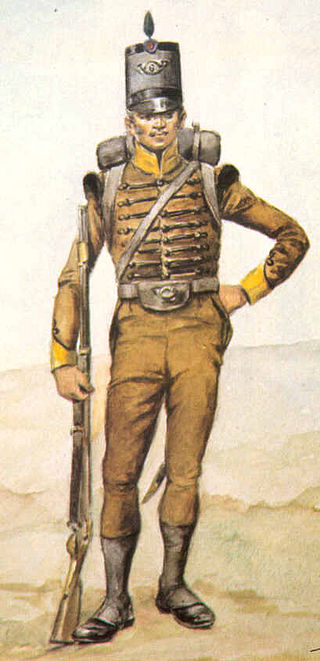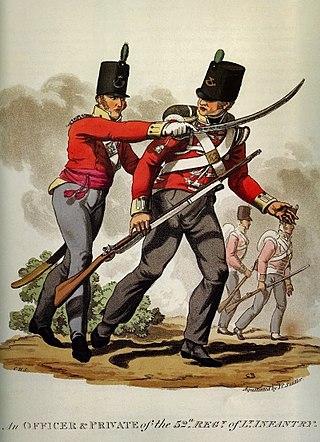
Infantry is a military specialization which engages in ground combat on foot. Infantry generally consists of light infantry, mountain infantry, motorized infantry, mechanized infantry, airborne infantry, air assault infantry, and marine infantry.

A pike is a very long thrusting spear formerly used in European warfare from the Late Middle Ages and most of the early modern period, and were wielded by foot soldiers deployed in pike square formation, until it was largely replaced by bayonet-equipped muskets. The pike was particularly well-known as the primary weapon of Swiss mercenary and German Landsknecht units. A similar weapon, the sarissa, had been used in antiquity by Alexander the Great's Macedonian phalanx infantry.

Friedrich Wilhelm August Heinrich Ferdinand von Steuben, also referred to as Baron von Steuben, was a Prussian military officer who played a leading role in the American Revolutionary War by reforming the Continental Army into a disciplined and professional fighting force. His contributions marked a significant improvement in the performance of U.S. troops, and he is subsequently regarded as one of the fathers of the United States Army.

Drill commands are generally used with a group that is marching, most often in military foot drills or in a marching band. Drill commands are usually heard in major events involving service personnel, reservists and veterans of a country's armed forces, and by extension, public security services and youth uniformed organizations.

Light infantry refers to certain types of lightly equipped infantry throughout history. They have a more mobile or fluid function than other types of infantry, such as heavy infantry or line infantry. Historically, light infantry often fought as scouts, raiders, and skirmishers. These are loose formations that fight ahead of the main army to harass, delay, disrupt supply lines, engage the enemy’s own skirmishing forces, and generally "soften up" an enemy before the main battle. Light infantrymen were also often responsible for screening the main body of a military formation.

Sepoy was the Persian-derived term from the world "sipahi" or a professional Indian infantryman, traditionally armed with a musket, in the armies of the Mughal Empire.

Early modern warfare is the era of warfare following medieval warfare. It is associated with the start of the widespread use of gunpowder and the development of suitable weapons to use the explosive, including artillery and firearms; for this reason the era is also referred to as the age of gunpowder warfare. This entire period is contained within the Age of Sail, which characteristic dominated the era's naval tactics, including the use of gunpowder in naval artillery.

The pike square was a military tactical formation in which 10 rows of men in 10 columns wielding pikes developed by the Swiss Confederacy during the 14th century for use by its infantry.

An infantry square, also known as a hollow square, was a historic combat formation in which an infantry unit formed in close order, usually when it was threatened with cavalry attack. As a traditional infantry unit generally formed a line to advance, more nimble cavalry could sweep around the end of the line and attack from the undefended rear or burst through the line, with much the same effect. By arranging the unit so that there was no undefended rear, a commander could organise an effective defense against a cavalry attack. With the development of modern firearms and the demise of cavalry, that formation is now considered obsolete.

Line infantry was the type of infantry that composed the basis of European land armies from the late 17th century to the mid-19th century. Maurice of Nassau and Gustavus Adolphus are generally regarded as its pioneers, while Turenne and Montecuccoli are closely associated with the post-1648 development of linear infantry tactics. For both battle and parade drill, it consisted of two to four ranks of foot soldiers drawn up side by side in rigid alignment, and thereby maximizing the effect of their firepower. By extension, the term came to be applied to the regular regiments "of the line" as opposed to light infantry, skirmishers, militia, support personnel, plus some other special categories of infantry not focused on heavy front line combat.

Infantry tactics are the combination of military concepts and methods used by infantry to achieve tactical objectives during combat. The role of the infantry on the battlefield is, typically, to close with and engage the enemy, and hold territorial objectives; infantry tactics are the means by which this is achieved. Infantry commonly makes up the largest proportion of an army's fighting strength, and consequently often suffers the heaviest casualties. Throughout history, infantrymen have sought to minimise their losses in both attack and defence through effective tactics.

The Coalition forces of the Napoleonic Wars were composed of Napoleon Bonaparte's enemies: the United Kingdom, the Austrian Empire, Kingdom of Prussia, Kingdom of Spain, Kingdom of Naples, Kingdom of Sicily, Kingdom of Sardinia, Dutch Republic, Russian Empire, the Ottoman Empire, Kingdom of Portugal, Kingdom of Sweden, and various German and Italian states at differing times in the wars. At their height, the Coalition could field formidable combined forces of about 1,740,000 strong. This outnumbered the 1.1 million French soldiers. The breakdown of the more active armies are: Austria, 570,000; Britain, 250,000; Prussia, 300,000; and Russia, 600,000.

The French Revolutionary Army was the French land force that fought the French Revolutionary Wars from 1792 to 1804. These armies were characterised by their revolutionary fervour, their poor equipment and their great numbers. Although they experienced early disastrous defeats, the revolutionary armies successfully expelled foreign forces from French soil and then overran many neighboring countries, establishing client republics. Leading generals included Napoleon Bonaparte, Jean-Baptiste Jourdan, André Masséna and Jean Victor Marie Moreau.
The infantry in the American Civil War comprised foot-soldiers who fought primarily with small arms, and carried the brunt of the fighting on battlefields across the United States. Historians have long debated whether the evolution of tactics between 1861 and 1865 marked a seminal point in the evolution of warfare. The conventional narrative is that generals and other officers adhered stubbornly to the tactics of the Napoleonic Wars, in which armies employed linear formations and favored open fields over the usage of cover. Presumably, the greater accuracy and range of the rifle musket rendered that approach obsolete, and the Civil War armies' transition to longer battles in 1864 is taken by numerous scholars as proof of the new technology's transformative impact. More recently, however, academics have begun to reject this narrative. Earl J. Hess judges the tactical training of the Civil War as critical to the armies' success, and maintains that the dearth of overwhelming victories during the conflict was actually consistent with the infrequency of such battles throughout history. Allen C. Guelzo contends that rifle muskets did not revolutionize land warfare due to a combination of inadequate firearms training and the poor visibility caused by black powder. This debate has implications not only for the nature of the soldier's experience, but also for the broader question of the Civil War's relative modernity. Williamson Murray and Wayne Wei-Siang Hsieh argue that the conflict was resulted from "the combination...of the Industrial Revolution and French Revolution [which] allowed the opposing sides to mobilize immense numbers of soldiers while projecting military power over great distances." The War involved a number of other recently introduced and new technologies, including military balloons, repeating rifles, the telegraph, and railroads.

Military step or march is a regular, ordered and synchronized walking of military formations.

The British Army during the Napoleonic Wars experienced a time of rapid change. At the beginning of the French Revolutionary Wars in 1793, the army was a small, awkwardly administered force of barely 40,000 men. By the end of the period, the numbers had vastly increased. At its peak, in 1813, the regular army contained over 250,000 men. The British infantry was "the only military force not to suffer a major reverse at the hands of Napoleonic France."
The history of British light infantry goes back to the early days of the British Army, when irregular troops and mercenaries added skills in light infantry fighting. From the beginning of the nineteenth century, the Army dedicated some line regiments as specific light infantry troops, were trained under the Shorncliffe System devised by Sir John Moore and Sir Kenneth MacKenzie Douglas. The light infantry had the nickname "light bobs" first used during the American Wars of Independence, and commonly applied to the Light Division during the Napoleonic wars.
Roman infantry tactics refers to the theoretical and historical deployment, formation, and manoeuvres of the Roman infantry from the start of the Roman Republic to the fall of the Western Roman Empire. The focus below is primarily on Roman tactics: the "how" of their approach to battle, and how it stacked up against a variety of opponents over time. It does not attempt detailed coverage of things like army structure or equipment. Various battles are summarized to illustrate Roman methods with links to detailed articles on individual encounters.

Volley fire, as a military tactic, is the concept of having soldiers shoot in the same direction en masse. In practice, it often consists of having a line of soldiers all discharge their weapons simultaneously at the enemy forces on command, known as "firing a volley", followed by more lines of soldiers repeating the same maneuver in turns. This is usually to compensate for the inaccuracy, slow rate of fire, limited effective range and stopping power of individual weapons, which often requires a massed saturation attack to be effective. The volley fire, specifically the musketry volley technique, requires lines of soldiers to step to the front, fire on command and then march back into a column to reload, while the next row repeats the same process.

The military forces of the Afsharid dynasty of Iran had their origins in the relatively obscure yet bloody inter-factional violence in Khorasan during the collapse of the Safavid state. The small band of warriors under local warlord Nader Qoli of the Turkoman Afshar tribe in north-east Iran were no more than a few hundred men. Yet at the height of Nader's power as the king of kings, Shahanshah, he commanded an army of 375,000 fighting men which, according to Axworthy, constituted the single most powerful military force of its time, led by one of the most talented and successful military leaders of history.

















